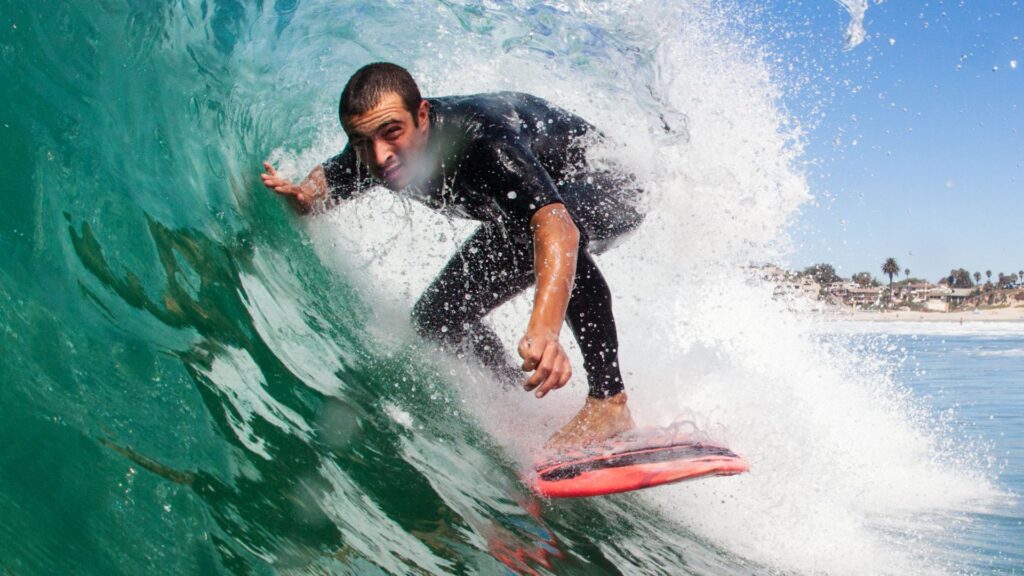Climate change is emerging as a significant global concern, and its effects are felt in various industries, including surfing. This exciting activity, which has become a way of life for many people, faces significant challenges due to environmental impacts and climate variations.
Oceanic Impact: Climate Regulation, Carbon Absorption, and Disturbing Trends
These impacts significantly affect the oceans, which play a crucial role as climate regulators by absorbing heat and carbon dioxide. The oceans are essential to the climate balance, as they can capture about half of the carbon released into the atmosphere, making them the leading carbon sinks. Moreover, according to research published in Geophysical Research Letters, the oceans have absorbed more than 93% of the heat generated by human activities since the 1950s.
This capacity of the oceans to absorb carbon dioxide plays a fundamental role in mitigating climate change. However, climate change is causing harmful alterations such as temperature increases, rising sea levels, and acidification.
According to U.S. National Oceanic and Atmospheric Administration data, the oceans have recorded a record high temperature, reaching 21.1°C (70°F). This represents the highest seawater temperature in at least the last four and a half decades. According to the information presented, more than 90% of the increase in temperature is attributed to the rise of greenhouse gases in the atmosphere, resulting from activities such as the burning of fossil fuels and deforestation.
Rising Seas, Surfing Sustainability, and Climate-Conscious Solutions
On the other hand, according to the United Nations, the rise in sea levels in the oceans has accelerated in recent decades due to the increase in melting ice in the planet’s polar areas. The most recent data from the World Meteorological Organization show that the global average sea level has reached a new historical maximum in 2021, with an average increase of 4.5 millimeters per year from 2013 to 2021.
In addition, this growth has resulted in a gradual loss of wave quality at many famous surfing beaches. Coastal erosion and changes in wave patterns have impacted the regularity and formation of waves suitable for surfing, thus threatening the sustainability of surf schools and local surfing businesses.
Historically, the surf industry has been heavily tied to petroleum-derived materials, such as the polyurethane foam used to manufacture surfboards. The production process of these materials contributes significantly to greenhouse gas emissions and environmental pollution. As climate change worsens, there is an urgent need to look for more sustainable and environmentally friendly materials to reduce the environmental impact of this industry.
Surf Industry Growth Amidst Climate Challenges
Currently, the surf industry generates a total of US$4 billion, with an annual growth rate of 4%, and will reach US$5 billion between 2027 and 2028, according to a market study by ReportLinker. However, the increased frequency and severity of extreme weather events, such as storms and hurricanes, impact the production and distribution of surfboards. Numerous organizations associated with the surfboard manufacturing value chain have been experiencing damage related to climate change, causing delays in production, which has affected the supply of equipment to surfers and has led to an increase in production and transportation costs and, consequently, the final selling price to athletes.
Fortunately, increased awareness of implementing more sustainable and environmentally friendly practices has increased the use of alternative materials in surfboard production. For example, some companies have used biodegradable and recycled materials and foams made from natural elements. These initiatives reduce the carbon footprint and improve the performance and durability of the equipment.
Sustainable Innovations and Initiatives in the Surf Industry
An example of best practice in the surf industry is “Smart Wax,” a product developed by the Clean Ocean Foundation. It uses a natural substance to neutralize harmful acids and transform them into pure water. This innovative product can be used in any surf wax formula. With this new product, the Clean Ocean Foundation urges surf wax brands to incorporate the use of Calcium Carbonate in their products in exchange for gradually contributing to neutralizing the increase of acidity in the ocean because of climate change.
Another example is the innovative project led by a group of biology and chemistry students at the University of San Diego, collaborating with Arctic Foam, the largest board manufacturer in the United States, where polyurethane was replaced with a more environmentally friendly alternative. Through a chemical transformation of algae oil, they obtained various polyols that expand and solidify, creating a substance similar to polyurethane foam that can float on water.
Speaking of good practices related to the surf industry, it is also important to highlight an innovative and sustainable example of the primary input surfers use to care for their skin, in which Avasol stands out. This company has created sunscreens based on natural medicinal and ethnopharmacology, offering them in biobased and refillable packaging to reduce the waste load on the earth.
Voices and Actions in the Surf Community
According to Emma Danzo, Avasol Manager for Marketing, Partnerships, and Social Media – “It’s easy to overlook the individual effects of the materials we introduce into the ocean through our surfing equipment, but together they have a large impact, and it’s up to us to turn the tide on the cumulative effect of our actions in the ocean. With Avasol, there’s no need to sacrifice sustainability for sun protection. As waterpeople, it’s our duty and privilege to protect that which gives us so much life and love.“
It is also essential to mention Olas Surf School Peru, with more than 31 years of experience in the surfing industry, has been developing strategies to position itself as the first surf school to promote climate and environmental awareness through the carbon-neutral certification of its operations. Roberto Meza, Director of the Olas Peru Surf School, tells us that Olas Peru has been developing educational programs for beach protection and environmental conservation through activations such as beach cleanups along the coast, acquisition of ecological garbage cans, as well as participating directly in the work plan for the approval of the law for the protection of surf breaks.
The Wave of Change and the Future of Surfing
In conclusion, Climate change impacts the surf industry, affecting sea conditions and posing challenges to the sustainability of the materials used to manufacture boards and equipment. However, this situation has generated greater awareness and a search for innovative solutions that are more environmentally friendly. We, as surfers, need to take this case personally, spreading the word and recognizing that there is much space for improvement in processes, materials, and waste management. All sectors of the surf industry have an essential role to play, no matter the size or the activity, from surf schools to fins.
If the surf industry continues to adopt good climate practices and eco-friendly materials, it could pave the way for a more hopeful future, where surfers can enjoy their passion while protecting the oceans and the environment for future generations.
Written by Musye Lucen, from The Green Initiative Team.






